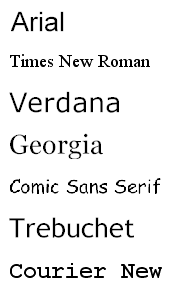


Webmaster Articles > Web Safe Fonts
Find out how to choose the right typeface for your website.
 Choosing the right typeface for your website copy is important, since it will
affect the way your readers perceive your page (serious and formal, or friendly
and casual). Aside from this, there are also important usability concerns.
For example, some font types are more easily readable than others, and some
are more widely available.
Choosing the right typeface for your website copy is important, since it will
affect the way your readers perceive your page (serious and formal, or friendly
and casual). Aside from this, there are also important usability concerns.
For example, some font types are more easily readable than others, and some
are more widely available.
You want to choose font types that:
- fit the character of your site,
- are easy to read on a computer screen, and
- are widely available across many browsers and operating systems.
There are basically two types of fonts: serif and sans serif. Serif fonts are those that have fine cross-lines at the extremities of the letter. Sans serif ("sans" being the French word for "without") are fonts that don't have serifs. The most common serif font is probably Times New Roman. Arial is an example of a common sans serif font.
Let's go briefly through the most popular font types and evaluate their availability, readibility and character:
Arial:
- Availability: Thoroughly available. It is probably the most common sans serif font. It is the default font for Windows, and it first shipped as a standard font with Windows 3.1.
- Readability On Screen: Not the worse but definetely not the best, especially at small sizes, when it becomes too narrow and the spacing between characters too small.
- Character: Has a streamlined, modern look but is also plain and boring.
*For Mac users, the equivalent of Arial is Helvetica.
Times New Roman:
- Availability: Thoroughly available. It is probably the most common serif font. It is the default font for web browsers. It was first shipped as a standard font with Windows 3.1
- Readability On Screen: Acceptable for font sizes of 12pt. and up, but terrible for smaller sizes.
- Character: Serious, formal and old fashioned.
* For Mac users, the equivalent of Times New Roman is Times.
Verdana:
- Availability: A widely available sans serif font, Verdana was first shipped with Internet Explorer version 3, when the exponential growth of the Internet demanded a new font that was easy to read on the screen.
- Readability On Screen: Exceptional. It's wide body makes it the clearest font for on-screen reading, even at small sizes.
- Character: Modern, friendly and professional.
Georgia:
- Avaliability: Good. It is a serif font introduced by Microsoft with Internet Explorer version 4, when the need for a serif font which much better readability than Times New Roman became evident.
- Readibility On Screen: Very good. It is the best serif font for on-line reading, since it was specifically designed for that purpose.
- Character: Modern, friendly and professional.
Microsoft has also popularized two more fonts: Comic Sans Serif and Trebuchet.
Comic Sans Serif was launched with Internet Explorer verion 3 and mimics the hand writing used in comics. It is easy to read and is informal and friendly, but it is not considered appropriate for more serious, professional sites.
Trebuchet is another sans serif font, similar to Arial but with more character, although it can be difficult to read in small sizes.
Finally, we can mention Courier New, a serif font that was widely popular with old, mechanical typewriters, and that is now used only to present simulated computer code (if you need to present snipets of sample HTML code in your web pages, this is the font to use.
Therefore, from a usability perspective, the clear winner is Verdana. If you are inclined to use a serif font, Georgia is the best option. Arial remains a good option for specific parts of text, like headlines and titles, where a different font must be used and you can use larger sizes.
The way you specify your desired font in HTML is by using the <font face> attribute. The best practice is to specify several fonts instead of just one, putting the easiest to read first.
For example, if you want to use serif fonts, your HTML code will look like this: <font face="Georgia, Times New Roman, Serif">. That way, your visitor's browser will try to load Georgia first, but if it doesn't have it installed it will try the next one on the list, in this case Times New Roman; if it doesn't have it either, which is highly unlikely, the browser will choose the third option, which we have specified as any other serif font.
For sans serif fonts, the code will look like this: <font face="Verdana, Arial, Sans">.
Mario Sanchez publishes The Internet Digest,
an internet marketing content site packed with useful articles and resources, and
SEO Tutorial, where
you can learn the basics of search engine optimization in four easy steps.



